This post is a continuation of the one published in November 2019 “Charley Toorop in the IVAM Valencia and the social realism” [see here]. In that we refer, to the thread of the comment on the exhibition that was being held at the IVAM at that time Reinventing the representation: Dutch interwar art ―with an abundant presence of works by Charley Toorop―, to the linking of the work of this artist with that of her father Jan Toorop, and now we have to refer to the work of her son John Fernhaut (John Ferno in the credits of the movie The Spanish Earth that can be seen above), which did not escape the influence of the Toorop. We were then discussing Charley Toorop’s close relationship with Joris Ivens, an active participant in the activities of the Dutch Filmliga, which had its organ of expression in i10 magazine, a leading-edge magazine founded by Charley Toorop and her partner Arthur Müller-Lehning. In fact, Joris Ivens, who needs no introduction (one of the great classics of the documentary, along with Grierson, Flaherty or Dziga Vertov), was a regular at the Toorop house in Bergen (40 km north of Amsterdam), probably Indo -Dutch like the whole family (although it is not often said in their biographies), if you look at their Asian features. In this atmosphere, little John Fernhout (Bergen 1913 – Jerusalem 1987) with only 15 years old was already learning cinematography in a practical way helping Joris Ivens; later, in a more academic way, in Paris and Berlin. In Berlin he met Robert Capa (Gerda Taro?) And Eva Besnyö, who would follow him when he returned to the Netherlands, fleeing persecution of the Jews. In 1937 he made a propaganda documentary film for the Dutch Communist Party, with the pseudonym Pieter Bruggens, and that same year he left with Joris Ivens to Spain to record The Spanish Earth, in which he appears in the credits as responsible for photography with another pseudonym, that of John Ferno (although there is discussion about the authorship of the film, because according to his son Douwes, there would be, at least, a shared authorship between them, that Joris Ivens did not want to recognize John Fernhout, being a reason for separation between the two for years until they meet again to record films in China together, in the final stretch of the life and work of Joris Ivens).
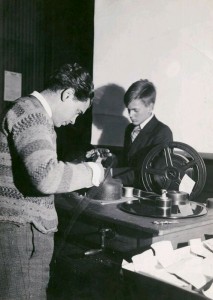 Apprentice John Fernhout with Joris Ivens.
Apprentice John Fernhout with Joris Ivens.
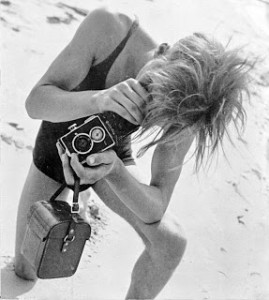 At 24 years old photographed by Eva Besnyö.
At 24 years old photographed by Eva Besnyö.
The Spanish Earth is a creative documentary in which a large group of personalities participated making diverse contributions (keep in mind that this is a film shot in the middle of the war, in which all those who participate, in addition to doing their best to save their own lives, they end up collaborating on everything: from contributing script ideas, selecting scenarios, transporting material (by hand if necessary), and there were John Dos Pasos, Ernest Hemingway, the narration by Orson Welles in one of the editions of the film, etc.
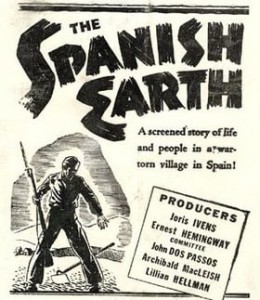
Returning to our protagonist, John Fernhout was during the entire filming in Spain, even afterwards for the editing of the film, while Joris Ivens went to New York. John Fernhout is a character that arouses enormous curiosity. He was separated by his mother from the family genealogy that he represents in Drie generaties [Three generations], 1941, a painting by Charley Toorop in which she appears self-portraying with his father Jan Toorop (a sculpture by John Radecker, which can be seen in Roterdam at the Museum Boijmans), and one of his sons (Edgar Fernhout), who would follow in his footsteps as a painter. According to Douwes―the son of John Fernhout (in a documentary about his life in development), John would be separated from the family when one day, when he was twelve or thirteen, he said that he wanted to go to the cinema and his mother told him that if he went to the cinema that he did not return home, and indeed he stayed on the street. However, with this anecdote, paradoxically, he synchronizes with his grandfather Jan Toorop, who was also separated from his parents, first for studies and later because of bad luck: they had to come to say goodbye to him when he left Batavia (Jakarta), after 4 years separated from them by studies in the capital, and when he had to see them for the last time before moving to Europe to continue his studies in Amsterdam and Delft, the boat they were coming from on Bangka Island had a mishap and arrived belatedly, by then Jan Toorop had already left Batavia. He would never see them again.
John Fernhout was a man with a strong personality, from film productions that exceeded the systematically allocated budget, scarcely recognized in the Netherlands (until recently). However, his productions have had great popularity in England and the United States (especially his documentaries about the war). The Spanish Earth is, without a doubt, one of his great works. Once the film was finished, the film traveled to the United States where it had its origin, and where it was used to raise large sums of money to help Republicans (especially with medical supplies), thanks to the support of President Roosevelt and all the film establishment of the time (Ernst Lubitsch, Fritz Lang, King Vidor, Lewis Milestone, Anatol Litvak and John Cromwell, the actors Robert Montgomery, Myriam Hopkins, Errol Flynn, Joan Bennet and the writers Dashiell Hammett, Dudley Nichols, Dorothy Parker and Marc Connelly supported the film in some way). In Spain the film was released in 1938 in Barcelona and Madrid with great success, in a version dubbed into Spanish of which no copy is preserved. However, the sardanas heard on the soundtrack were widely criticized, because “it seems sacrilege for the Andalusians in Madrid (sic). Buñuel was not satisfied at all and we have decided that for the Spanish version, which we will do in the future, we will change the music. There (in Spain) people are very sensitive to these differences” (statements by Joris Ivens that appeared published in L’Avant-Scène du Cinéma, 259-260 [1981], p. 5).

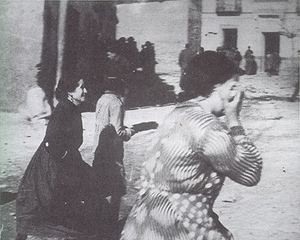
The Spanish Earth not only shows the Spanish Civil War, but also tells the story of a group of farmers who cultivate their land during this period. In this sense, the film is developed on two levels. On the one hand, the viewer faces all facets of the war: heroism and horrors, soldiers fighting against fascism and foreign intervention, the trenches, the wounded, as well as images of Madrid, devastated by the German and Italian bombs. On the other hand, in a relatively peaceful atmosphere, we see the farmers of a small town who still own their land and that having the knowledge and the means to cultivate it, as the fight is fought in the front, this does not prevent them from cultivating the land and, subsequently, supply the combatants.
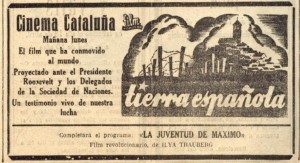
The film was recorded, in that second level that shows life in the countryside, in the town of Fuentidueña (Segovia). They have never seen the movie in town. In fact, on Wikipedia, in the Fuentidueña voice, there is no reference to the film. It seems that nobody remembers that once that small town was the setting, the landscape, and its inhabitants the protagonists of a cult movie.

